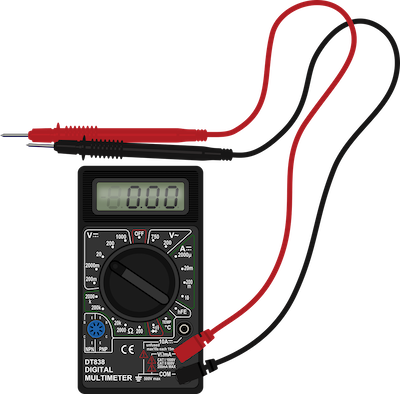How To Test An Alternator With A Multimeter
An alternator charges the battery and other electrical components of a car while it is running. A bad alternator can cause several issues like weak lights and the vehicle engine being unable to crank and turn on. A multimeter can test an alternator in several ways to determine its condition. This article explores the various methods of checking an alternator using a multimeter.
Table of contents
- What is an alternator?
- Bad alternator symptoms
- Car battery voltage
- How to check an alternator with a multimeter
- FAQs
View our online selection of clamp meters and multimeters!
What is an alternator?
An alternator, also called a synchronous generator (Figure 1), is a device used to generate AC (alternating current) power at a specified frequency. Alternators use coils wrapped around an iron core to produce electricity by electromagnetic induction. A coil can generate electricity in two ways:
- Rotating the coil with respect to a stationary magnetic field.
- Rotating the magnetic field around a stationary coil.
An alternator uses the second approach. The two main parts of an alternator are:
- Rotor: A DC (direct current) power source produces a magnetic field, which excites the rotor coils. The rotor rotates with the help of a prime mover, which is the car engine. This rotation causes the flux created by the rotor to rotate at the same speed as the rotor.
- Armature coils: The armature coils are stationary. The rotating magnetic flux in the rotor induces electricity in the armature coils.
An alternator is primarily used in automobiles to charge the battery while driving. It is also used in conventional energy generating platforms like nuclear, gas, thermal, and hydropower stations.
Bad alternator symptoms
If a car doesn’t start, despite having a good battery, the alternator may be bad. Look for the following signs that indicate a weak alternator:
- Illuminated battery light on the dashboard.
- Slowly cranking engine or engine not cranking at all.
- The vehicle's electrical components, like headlights, batteries, and interior lights, seem weak. An underperforming alternator may produce weak lights, whereas an overcharging alternator produces extra bright lights.
- The alternator makes rumbling sounds.
- A burning smell may indicate electrical issues within an alternator.
- The vehicle fails to jump start.
Car battery voltage
In most cases, car batteries have a resting voltage between 12.4 and 12.6 volts. The voltage produced at the alternator drops as it travels through the wires throughout the vehicle. To compensate for this drop, the alternator produces a higher voltage, typically 14.5 volts.
When the car is running, the voltage measured across the car battery varies from one vehicle to another because of the voltage drop. But always ensure that the battery voltage in the running state is higher than the battery’s resting voltage. In most cases, the car battery produces a voltage of nearly 14 volts or slightly above when the vehicle runs with all electrical accessories off.
How to check an alternator with a multimeter
A multimeter is a handheld device that measures multiple parameters of an electric circuit like the voltage, current, and resistance. Multimeters are often used to test a questionable battery.
The multimeter’s leads are connected to the battery to measure the DC voltage across it and decide whether it is good, dead, or produces an intermediate voltage. Connect the red probe to the VΩmA socket and the black probe to the COM socket on the multimeter for voltage, resistance, and continuity measurements, as seen in Figure 2. The different methods used to test an alternator are discussed below.
Checking the car battery’s voltage in standby and running conditions
As previously discussed, the main purpose of the alternator is to charge the battery. Therefore, one of the quickest and easiest ways to initially test an alternator is to simply test the car battery's voltage. For a more in-depth overview, read our article on how to check a car battery with a multimeter.
- Turn off the car engine.
- Rotate the multimeter dial and set the knob to measure DC voltage in the range of 15-20V, as seen in Figure 2. The general rule of thumb is to select a value on the multimeter that is the smallest number greater than the voltage to be measured.
- Connect the positive (red) and negative (black) leads to the positive and negative terminals of the car battery, respectively.
- Check the multimeter’s display and note the voltage produced. The value should be approximately 12-13 volts. If the value is below 12V, charge the battery with a battery charger before proceeding to the next step.
- Start the car, and use the multimeter to recheck the battery voltage while the vehicle is running. If the value lies somewhere between 14 and 15 volts, the alternator is working as it should. If the alternator is working correctly, an active computer module that fails to shut down when the car is off may be draining the battery.
- If the noted voltage remains constant or drops when the vehicle is running, see the additional methods discussed below.
Note: There are two types of voltage measurements in a multimeter, AC (represented as V~) and DC (represented as V–), as seen in Figure 2. Select the DC voltage to measure the voltage generated by a car battery or alternator.

Figure 2: Multimeter dial set to measure DC voltage under 20V.
Loading the car’s electrical system
- Keep the car running and use a multimeter to check the battery voltage, as discussed in the previous section.
- Turn on all the heavy loads. For example, turn on the lights, radio, fan, and heater blower motor.
- Connect the positive (red) and negative (black) leads of the multimeter to the positive and negative terminals of the car battery, respectively, and note the voltage shown on the multimeter’s display.
- Compare the voltage value with the value when the additional loads were turned off (13-14V). If the number has dropped significantly to less than 13V, it may be a sign that the alternator finds it hard to keep up with the electrical system’s demand.

Figure 3: Checking a car battery using a multimeter
Checking the alternator directly
A user can directly check an alternator when there is easy access to the equipment within the vehicle.
- Locate the alternator within the vehicle and ensure its belt isn’t loose.
- Rotate the multimeter dial and set the knob to measure DC voltage in the range of 15-20V.
- Start the car engine. Check whether the alternator belt is spinning properly without slipping.
- Connect the positive (red) lead to the red-colored terminal from the alternator.
- Touch the negative (black) lead of the multimeter to any metallic part of the car frame (like a bolt head within reach or the negative terminal of the car battery). But never ground to the alternator itself.
- Note the reading on the multimeter display.
- If the alternator is working well, the multimeter reads somewhere around 13-14V. If the noted value is excessively high (greater than 15V), it may indicate that the alternator’s voltage regulator has gone bad. If the reading is lower than 13V:
- The engine idle speed may be inadequate for the alternator to produce sufficient voltage. In this case, try revving up the engine to 2000 rpm or a higher value and retake the readings. If the voltage read by the multimeter is still low, ensure that all the connectors on the alternator are tight and that the alternator belt is spinning correctly and not slipping.
- If the alternator is still not delivering enough power, the alternator’s voltage regulator may have gone bad, or the alternator itself may need changing.
Disconnecting the battery from the car
- Disconnect the battery while the car is running.
- If the car continues to run, the alternator produces enough voltage to run the engine. If it doesn’t, the alternator isn’t producing sufficient voltage.
Note: This method can cause severe damage to the alternator; hence, it is not advisable to try this technique unless there is an emergency.
FAQs
How do I test to see if my alternator is bad?
Remove the negative cable from the battery while the car engine is running. If the vehicle stalls, the alternator may be bad. Alternatively, use a multimeter to check the voltage generated by the alternator to determine if it is fit for use.
What voltage should an alternator test at?
13.5 - 14.5 volts








